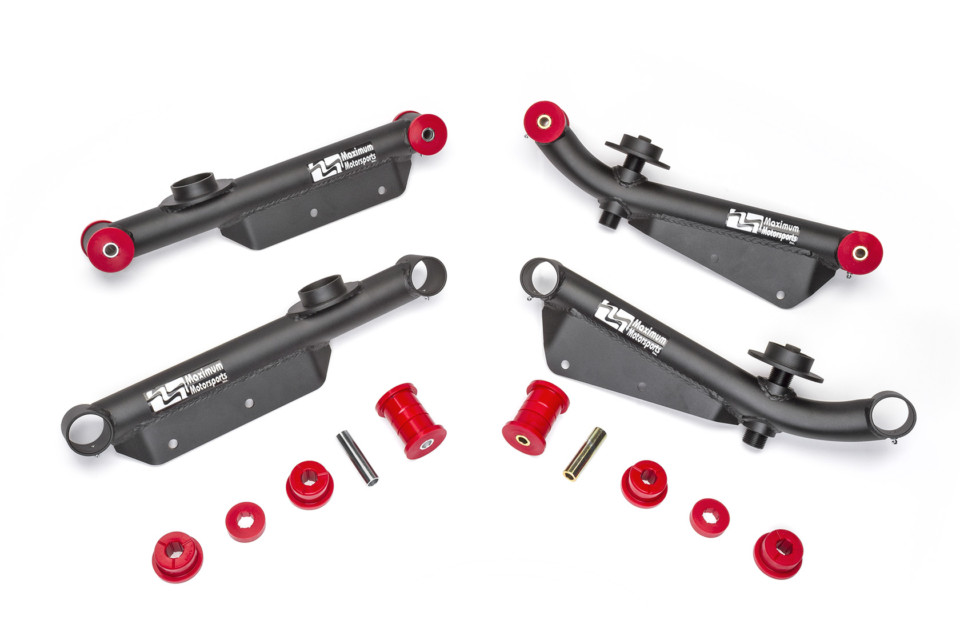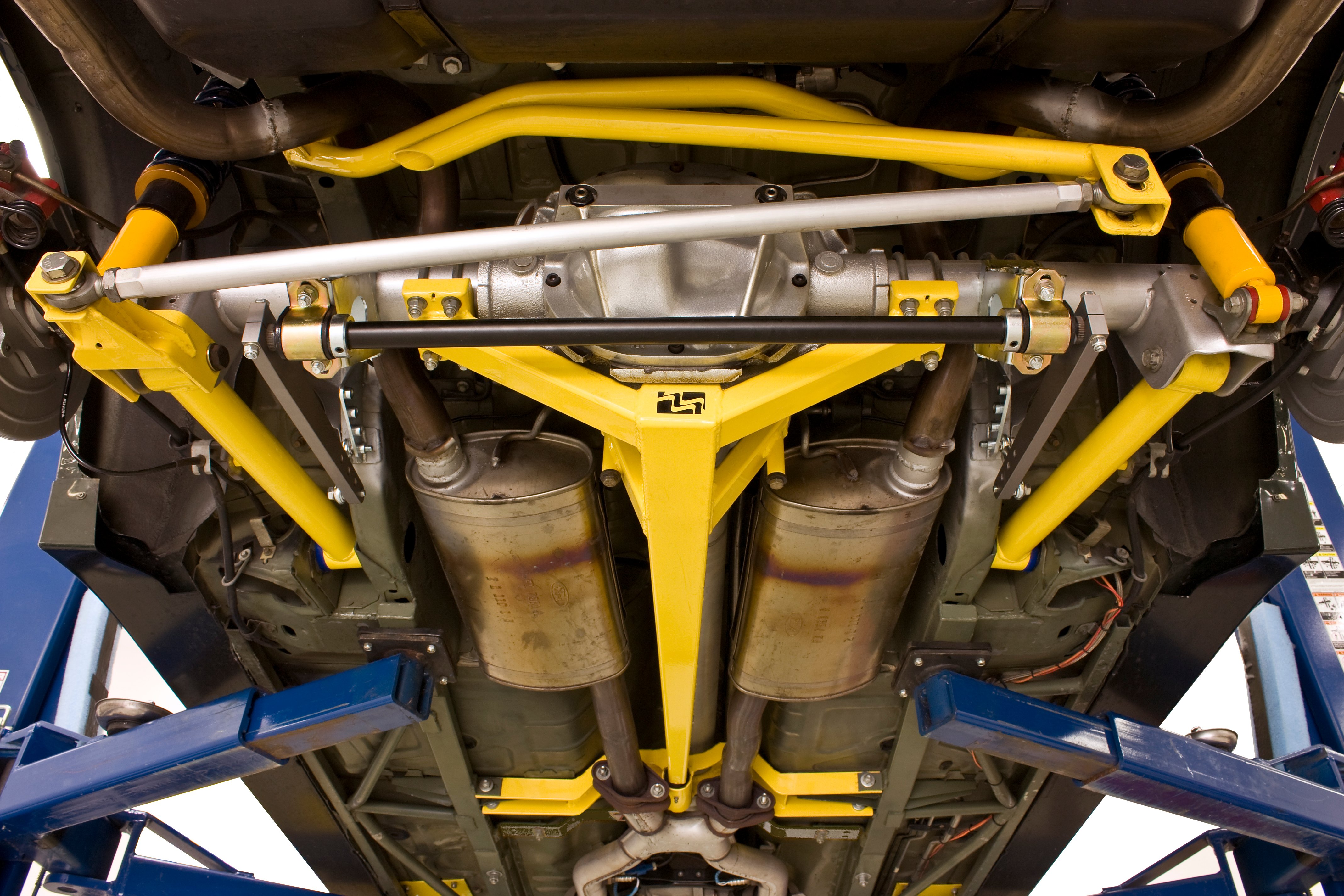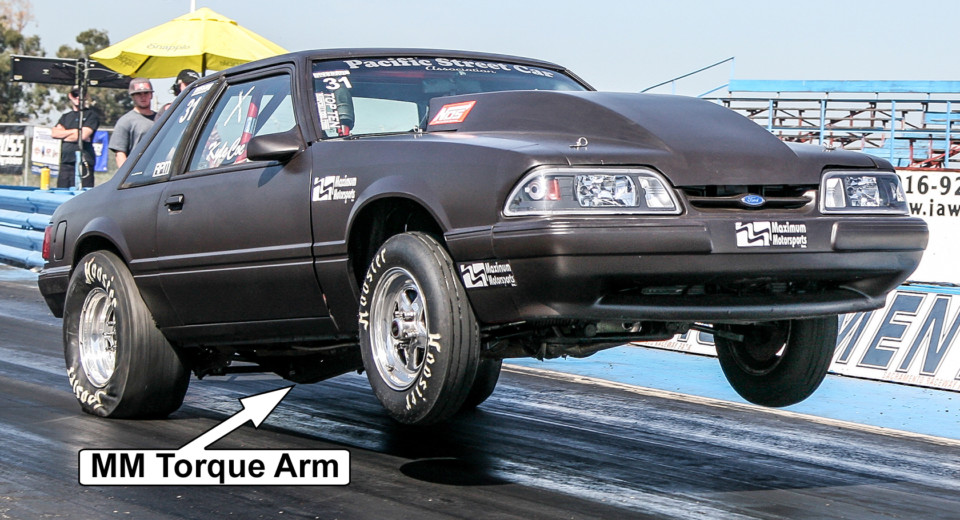Let’s be honest, deciding on a suspension system for your SN95 or Fox-body can be pretty overwhelming – especially if you’re not a suspension expert. There are so many options on the market, that deciding what might work best for your individual application can be tricky. Luckily, we were able to get the inside scoop on several suspension set-ups straight from the CEO of Maximum Motorsports, Chuck Schwynoch.
We asked Chuck to walk us through the technical advantages and disadvantages of the following rear suspension setups: an upgraded stock 4-link, a 5-link (which is really a 4-link with the addition of a Panhard bar), torque arm, and an independent rear suspension conversion. He also explained how these systems operate throughout entry, mid-corner, and exit, and what types of driving styles each system is best for. So, if you’re looking to invest in a new suspension system for your Mustang, read on!
Upgraded Stock 4-Link
To simplify this 4-link discussion even further, Chuck led us to separate it into two different categories. First, we’ll focus on the stock 4-link set up with an emphasis on handling, followed by a stock 4-link set up for drag racing. According to Chuck, each setup provides for a very different handling experience.
A 4-Link Upgraded for Improved Handling
For Maximum Motorsports customers looking to upgrade their existing 4-link system for handling purposes, Chuck tells us that they recommend upgrading the Rear Lower Control Arms (RLCAs) while retaining the stock Upper Control Arms (UCAs) and stock upper arm rubber bushings.
“Considering the age of these cars, ‘retain’ usually means replacing with new stock parts,” he explains.
Advantages
- Inexpensive
- Easy to install
- Greatly reduces, if not eliminates, the occurrence of wheel hop during hard acceleration
- Improves vehicle stability and handling predictability
Disadvantages
- When cornering, the Mustang will still have some degree of the unpredictable snap oversteer it exhibits with stock RLCAs
- Not a large improvement in rear tire forward grip (straight line traction) because there’s no change in the Anti Squat percentage and almost no change in the rear roll stiffness. There’s some improvement in forward traction because wheel hop is reduced or even eliminated.
- Retains the stock limit to the maximum possible rear tire and wheel width because there’s no change in the extreme amounts of side to side rear suspension movement the stock suspension exhibits during hard cornering
Handling
- Decently good turn-in response
- While mid-corner tire grip is okay, handling when near the limit is still unpredictable because snap oversteer will still occur as the body rolls
- Subpar tire grip on corner exit because a 4-link rear suspension design is over constrained unless some of the control arms are able to change length as the body rolls. Without this ability, the suspension binds up, hurting traction. Obviously, the control arms don’t change length, but the effective length, the distance between any one arm’s pivot points, will change as the bushings deflect. The less the bushings deflect, the greater the suspension binding. That’s why Maximum Motorsports retains rubber bushings in the UCAs.
A 4-Link Upgraded Primarily to Improve Launch When Drag Racing

This photo shows Maximum Motorsport’s Drag Race Adjustable Height RLCAs. Spherical bearings exist at each end, and is rated at 1,000 ft-lb of torque. While this photo shows the Thunderbird version, the only difference is the length of the control arm. The blue urethane caps keep the control arm upright when the spring is loaded. Without them, the arm would flop over because of the spherical bearings at each end.
This setup typically includes RLCAs and UCAs having a bushing configuration that is detrimental to good handling. Spherical bearings, hard one or two-piece urethane bushings, or other solid bushing material are often utilized. Most control arm manufacturers use a bushing material that eliminates fore/aft deflection, therefore eliminating bushing deflection as a cause of wheel hop. These bushings often reduce the control arm’s freedom of angularity, causing suspension bind (hindrance to movement) which hurts handling ability.
Advantages
- There’s a greater reduction in the occurrence of wheel hop because the RLCA and UCA bushings deflect the least amount.
- Gives good rear tire forward grip on smooth surfaces when driving in a straight line. This occurs because the control arm bushings typically used for drag racing add even more bind to the 4-link, which greatly increases the rear roll stiffness. That makes the rear tire vertical loads more equal, which always gives more total forward grip, but only if the pavement surface is smooth.
Disadvantages
- Very poor rear tire grip when cornering
- Poor rear tire grip on surfaces that are not smooth
- This setup means a near certainty of eventual damage. Without reinforcement of the lower torque boxes and UCA mounts, and welding the axle tubes to the center section, damage to those areas will eventually occur. Even after reinforcement, some parts will still fail eventually due to the high stresses caused by the over-constrained nature of the 4-link suspension design.
- The cost of reinforcements required for longevity will greatly increase the cost too far above the initial parts purchase of RLCAs and UCAs
- Very poor ride quality
- Very high noise, vibration, and harshness (NVH)
Handling
- Very quick turn in, tending to oversteer, because the suspension binds up as the body starts to roll during cornering
- Okay rotation for getting the car turned at mid-corner, again because suspension bind leads to oversteer
- The car soon becomes very unstable during hard cornering because it tends to unload and lift the inside rear tire as the suspension binds up
- Very slow on corner exit as the inside rear tire will be very unloaded, or even off the ground, so very little throttle can be applied for acceleration
Adding a Panhard Bar to a 4-Link
When adding a Panhard bar to a 4-link system, Chuck explains that Maximum Motorsports always retains stock rubber bushings at both ends of the UCAs. He explains that this is a requirement for the suspension to move properly. MM also recommends that the RLCAs be upgraded, but to a version having bushings or spherical bearings that reduce fore/aft deflection as much as possible while also not hindering angularity changes of the RLCAs, relative to the mounts at each end.
Advantages
- Eliminates the typical Mustang rear-steer effect
- Makes the car much more stable, both when cornering and in a straight line
- Very predictable behavior when cornering
- RLCAs greatly reduce occurrence of wheel hop
- Provides a massive reduction in side to side rear suspension movement
- Moderate total cost of parts
- Practically a bolt-on, so no significant modifications to the car are required
- No appreciable change in NVH
- There’s no reduction in ride quality compared to the stock suspension
- Lowers the rear roll center from its stock location, which increases rear cornering grip
Disadvantages
- No large improvement in rear tire forward grip
- Limits aftermarket tailpipe selection to those that closely follow the factory tailpipe routing
Handling
- Good turn in due to lack of lateral movement of the rear suspension
- Good, predictable mid-corner grip because of the lower rear roll center determined by the Panhard bar
- Greater stability, tends to stay on the cornering line chosen, because the Panhard bar eliminates the inconsistent rear-steer effect
Torque-Arm Suspension System
Originally, we hadn’t thought to mention the Torque-Arm suspension system, but Chuck mentioned that it is an important option to consider! This solid-axle suspension type consists of RLCAs, a Panhard bar, the torque arm, and does not include UCAs. It’s a type of 3-link suspension.
Advantages
- Very predictable behavior when cornering
- Big increase in traction at corner exit
- Increased straight line traction
- Improved wet surface traction
- Most forgiving solid-axle suspension, and easiest to bring back under control after getting out of shape
- Massive reduction in side to side rear suspension movement
- Moderately high total cost of parts
- Mostly a bolt-on with some minor welding required. Exhaust modifications are sometimes required.
- Some added NVH
- Ride quality improved over the stock suspension
- Lowers the rear roll center from stock location, which increases rear cornering grip
Disadvantages
- May require exhaust system modifications, as it requires the H-pipe and mufflers to be very close to the stock locations
- Limits tailpipe selection to those that closely follow the factory tailpipe routing
- The increase in rear grip provided by a torque arm requires the addition of stiffer rear springs and/or a stiffer rear sway bar to restore handling balance when best handling is a priority
Handling
- Good turn in due to lack of lateral movement of the rear suspension
- Excellent and very predictable mid-corner grip because of the elimination of rear suspension bind
- Greatly improved ability to put power down on corner exit because of the elimination of rear suspension bind
IRS Swap to Replace a Solid Axle
Independent Rear Suspension (IRS) has been a hot topic the past few years, and for good reason. Ford originally introduced IRS in the 1999-2004 Cobra, but it wouldn’t be until 2015 that it was brought back as a model-wide vehicle feature. With a solid rear axle suspension, whatever happens to one wheel affects the connected wheel in the opposite motion, while IRS allows the rear tires to move independently of one another.
Advantages
- Much improved ride quality compared to a solid axle, under all conditions
- Allows adjustment of rear tire alignment which is essentially impossible with a solid axle
- Greater stability over bumps
Disadvantages
- Overall weight increases by 85 lb over a stock 8.8-inch solid axle
- Most expensive installation compared to the other rear suspension systems, what with the cost of IRS itself, plus upgraded IRS parts to improve performance, and the vehicle modifications required to install the IRS
- There are more parts that wear and require servicing over the long term
- Doesn’t have nearly as much anti-squat geometry as a solid axle installation can have, so rear tire forward grip is less than a well set-up solid axle suspension provides. This becomes ever more noticeable as the power level goes up.
Handling
- Once the IRS is upgraded with the appropriate performance parts, it has the most consistent handling balance of any rear suspension that can be installed in the rear of a Mustang
- Allows higher corner entry speeds, so less throttle is required on corner exit
- Has more mid-corner grip because the tire footprint stays flatter on the ground than with a solid axle
- Allows more rear brake bias than a typical solid axle installation, so the car can stop harder and in shorter distance
- Cannot tolerate as much throttle on corner exit as some solid axle suspensions
At the end of the day, the suspension set-up you choose depends mostly on how you plan to enjoy your Mustang. Whether you intend to drag race, road race, daily drive, or any combination of the three, Maximum Motorsports has a suspension option for you. If you’re still not sure which way to turn after reading this article, call the guys at MM and explain what you’re looking to get out of your Mustang. They’ll be able to point you in the right direction.

























